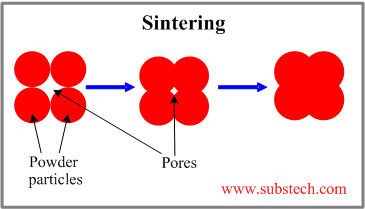Main page
About us
Sliding Bearings Consulting
Advertising Opportunities

to Ceramics
Sintering of ceramics
Dr. Dmitri Kopeliovich
Sintering (Firing) of ceramic materials is the method involving consolidation of ceramic powder particles by heating the “green” compact part to a high temperature below the melting point, when the material of the separate particles difuse to the neghbouring powder particles.
The driving force of sintering process is reduction of surface energy of the particles caused by decreasing their vapour-solid interfaces.
During the diffusion process the pores, taking place in the “green compact”, diminish or even close up, resulting in densification of the part, improvement of its mechanical properties.
Decrease of the porosity, caused by the sintering process, is determined by the level of the initial porosity of the “green” compact, sintering temperature and time. Sintering is enhanced if a liquid phase takes part in the process (liquid phase sintering).
Sintering (firing) of pure oxide ceramics require relatively long time and high temperature because the diffusion proceeds in solid state.
Applying pressure decreases sintering time and the resulted porosity.
Tunnel kilns and periodic kilns are commonly used for ceramics sintering (firing).
In periodic kilns heating and cooling sintering stages are conducted according to a prescribed procedure.
In tunnel kilns the sintered parts are conveyed through different temperature zones.
Typical tunnel kiln has three zones:
- Preheat zone for removing lubricant and other organic materials;
- Sintering zone where the diffusion occurs;
- Cooling zone where the sintered parts cool down.
Sintering process may be conducted in different atmospheres: air, inert atmosphere.
Sintering occurs simultaneously with pressing in the hot pressing processes (hot die pressing, hot isostatic pressing).
to top
Related internal links
to Ceramics



